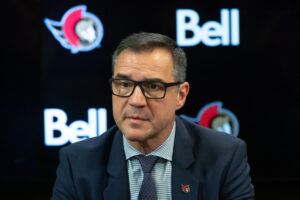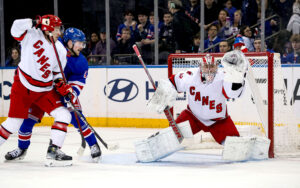In the fourth and final review of the San Jose Sharks 2018-19 season, we’ll cover the work of the management team. The previous articles reviewed the season, looked at the individual players and most recently, covered the coaching.
With the Sharks, the hockey side of the business is run by general manager Doug Wilson and he is the focal point of our review. Owner Hasso Plattner, a resident of Germany, is an occasional visitor. He rarely communicates with the media or fan base. When it comes to Sharks management, Wilson is the face of the franchise. We’ll touch on a few business-side issues, but things were largely status quo on this front.
Doug Wilson Gambles Twice
This season, Wilson took major gambles in going after elite talent.
In late June and early July 2018, Wilson pursued elite centre John Tavares in free agency. Tavares seemed a natural replacement for the ageing Joe Thornton.
Wilson’s plan for landing Tavares didn’t begin in 2018. He began carving out salary-cap space at least a year before Tavares hit the market. This was no small feat, but because Wilson began preparing long in advance, he was prepared when the opportunity arose. Alas, Tavares chose the Toronto Maple Leafs. With Tavares gone elsewhere, the game-changing opportunity for the Sharks was also gone. Or so most thought.
In September 2018, Wilson pulled off a stunning trade for two-time Norris Trophy winner Erik Karlsson. In return for Karlsson, the Ottawa Senators collected plenty of assets, but none of the premium variety.
The Sharks roster with Karlsson was the best in team history and perhaps the best in the NHL. However, it came with an important caveat. The roster could not be sustained beyond this season due to salary cap issues.
The Sharks All-In Season
The 2018-19 Sharks were all-in this season; Stanley Cup or bust. The Sharks made it to the Western Conference Final, but no further. Karlsson was a key piece, but injuries kept him from playing his best when games meant the most.
On the Karlsson trade, one has to give Wilson great credit. It is very tough to acquire elite talent and when it becomes available, teams need to find a way. Sharks management found that way. But all-in seasons require a championship and on that front, the Sharks came up short.
Wilson’s Plan
The Karlsson signing gave the Sharks two Norris Trophy-winning defencemen and created a dynamic no other NHL team could offer. The league’s two most prolific scoring defencemen were not partners, meaning the Sharks could play a point-per-game defenceman for the vast majority of a game.
One can point to a stretch in the season which validated Wilson’s vision. The Sharks had a modest start to the season while Karlsson proved an awkward fit. No one expected this to be a long-term issue and it wasn’t. In early December, the Sharks visited the lowly Senators, Karlsson’s former team. The Sharks lost badly, but that game marked the end of Karlsson’s struggles. What happened next was eye-popping.
The Elite Sharks
The loss in Ottawa was the last bad day the Sharks would have for a while. Over the next quarter of the season, they were the league’s apex predator. They posted a 16-3-2 record and routinely dispatched some of the league’s hottest teams. In the midst of this run was a ten-day stretch which showed what Wilson’s roster was capable of doing.
Taking Down Tampa
The Tampa Bay Lightning were on a spectacular 15-0-1 run when they skated into the Shark Tank on January 5th. The Sharks skated circles around the Lightning that evening. Lightning forward Nikita Kucherov won the Hart Trophy as the league’s most valuable player at season’s end. But at the Shark Tank, he finished without a point and was minus-4. At season’s end, Andrei Vasilevskiy won the Vezina Trophy as the league’s top netminder. The Sharks scored five times on him. Four of the five scores featured an assist from either Burns or Karlsson.
Victory in Vegas
Like the Sharks, the Vegas Golden Knights had a slow start to the season. But by the time the Sharks rolled into Vegas on Jan. 10, the Knights had turned things around. They were riding a season-high seven-game win streak where they’d outscored opponents 23-9. But the Sharks put three pucks past Marc-Andre Fleury and ended Knights streak. The Knights’ top forward line consisted of Jonathan Marchessault, Max Pacioretty and William Karlsson. Each finished minus-2. None of the three had a point in the game.
Pummeling the Pens
The Pittsburgh Penguins came to San Jose on January 15th, having won 10 of their prior 12. But they were no match for the Sharks. Sidney Crosby finished minus-2, Evgeni Malkin minus-3. Neither Pens star had a point. The Sharks didn’t merely beat the Pens, they were dominant overall — and even more dominant against their best players.
For 21 games, the Sharks were the best team in the league. Not only did they win consistently, but they were beating elite teams in the midst of their own hot streaks.
Dominating With Defence
This was the formidable team Sharks team management hoped for. Defenceman Brent Burns posted jaw-dropping numbers during the streak. He was plus-16 in those 21 games with 25 points. Posting these sorts of numbers usually means you’re the best defenceman in the league. But there was one who was better and it was his teammate. Karlsson’s numbers were ludicrous. Playing in 19 games during the run, he posted a plus-20 rating and tallied 27 points. It bears repeating, these two were not defensive partners so their numbers were mostly achieved independently of the other. Except on power plays, they were rarely on the ice at the same time.
Sharks management had put together a roster which was devastating the competition. Opponents saw one dominant defensive pair leave the ice and another dominant pair take over. Playing the Sharks was a nightmare for the league’s other teams.
On January 16th against the Arizona Coyotes, Karlsson injured his groin. The league’s nightmare ended and the Sharks nightmare began.
Questioning Sharks Management
If there was anything crystal clear about the Sharks hot streak, it was this: for the Sharks to be an elite team, Karlsson had to be healthy. But during the season, Karlsson never did return to full health. This raises uncomfortable questions.
With a healthy Karlsson essential to team success and the Sharks in the midst of an ‘all-in’ season, there was no reason to risk the player’s playoff health. And yet, somehow this happened. Karlsson returned in February after missing a month of action. In his third game back, he re-injured his groin. For some reason, the Sharks put him back into the line-up for the next game – and Karlsson injured his groin again. At this point, the Sharks shut down Karlsson until the regular-season finale. It was team’s only choice.
Unfortunately, Karlsson’s recovery schedule was dictated by the calendar instead of by his health. This can allow bad things to happen. Bad things happened. Karlsson’s health was compromised during the playoffs and though he played, he wasn’t close to the level he was before the injury.
How could the Sharks management allow Karlsson back onto the ice before a full recovery? Even more troubling, how could this happen more than once? There’s blame to go around. The coach and the medical staff are on the front line here. Still, as the team’s top hockey executive, Wilson is the one who has to ensure the right priorities are set and the appropriate business practices are in place. The risks of playing Karlsson in the regular season before he was fully recovered were huge. Nor was there any meaningful benefit to risk a premature return. And yet, this is what the Sharks did.
Sharks Going Elsewhere
There were noteworthy departures in the 2018 offseason. Wilson moved on from a number of veteran players. These included defenceman Paul Martin (via buyout), Eric Fehr, Jannik Hansen and Joel Ward. Of the four, only Fehr played in the NHL this season.
The Karlsson deal in September 2018 required assets to go the other way. The Sharks traded away two lower-end starters in Chris Tierney and Dylan DeMelo, plus two prospects and two high draft picks. Karlsson re-signed with the Sharks in June 2019, forcing other quality players to leave San Jose due to salary cap constraints (this is a subject we’ll address in more detail in future articles).
Wilson’s trade for Karlsson was the second deal he made with the Ottawa Senators in the 2018 offseason. Earlier, he sent Mikkel Boedker and a sixth-round pick for talented winger Mike Hoffman and a fifth-round pick. Each team also received a lower-end prospect from the other. Hoffman was moved later that same day along with a seventh-round pick to the Florida Panthers for a fifth, fourth and second-round draft pick. The latter pick factored into the Karlsson deal.
Acquired Sharks
Wilson made what appeared to be another key signing before the season started. Antti Suomela came over from Finland where he’d been a top player. As a Shark, though, Suomela didn’t cut it and he spent most of the season with the San Jose Barracuda, the Sharks’ AHL team.
Two midseason additions failed to move the needle sufficiently. Wilson brought in pugilist forward Micheal Haley who delivered what was expected of him. Which is to say, not a lot. Though Haley did have a few good moments, generally it’s a win for the other team when he plays. Unfortunately, he played a good bit, including 11 playoff games.
The other piece Wilson brought in was Gustav Nyquist, the scoring winger from the Detroit Red Wings. Nyquist had the potential to be a difference-maker. Playing alongside much more talent than he had in Detroit, Nyquist had a lot of upside potential. It didn’t work out that way. While his statistics were decent, he struggled to fit into the Sharks’ systems and contributed less than hoped.
The price paid for Nyquist was reasonable (a second and third-round draft pick). However, the cumulative cost of acquiring Karlsson, Evander Kane (the prior season) and Nyquist has added up. The Sharks pipeline is a bit sketchy and it appears it will be this way for a while. Multiple first-round picks are gone, multiple second-rounders are gone, a few picks in the middle rounds are gone and a couple of solid prospects are gone.
Managing the Salary Cap
It’s fair to ask: are the Sharks managing the salary cap or is the salary cap is managing the Sharks?
Wilson used up almost every bit of salary cap space possible for the 2018-19 season. He was partly constrained by the Paul Martin buyout, but this wasn’t the only meaningful hit. Two big-ticket additions took up a chunk of the cap. Karlsson’s cap hit was $6.5 million while newly signed Kane posted a $7.0 million figure. Three other players, Martin Jones, Marc-Edouard Vlasic and Logan Couture saw their paychecks jump, with a combined cap increase of $7.5 million. Jones’ cap hit went up to $5.75 million, Vlasic’s to $7.0 million and Couture’s to $8.0 million.
On the other side, Joe Thornton took a pay cut of $3.0 million resulting in a cap hit of $5.0 million. This provided Wilson the sliver of cap space he needed for the acquisition of Nyquist.
As noted earlier, the roster Wilson assembled was only viable for one season. Several Sharks had contracts set to expire this offseason and the pay raises were substantial, roughly $15 million. The league’s cap increase was $2.0 million, meaning there was no chance to keep the roster whole. Thus far, five players have departed Sharks Territory and will play next season elsewhere. Four of the five have substantial contracts for the upcoming season, with cap hits ranging from $3.8 million to $7.0 million for 2019-20.
A Worthwhile Risk?
The all-in nature of the 2018-19 season made sense. The Sharks proved they could be as good as any team in the league if healthy. Of course, health is often what separates Stanley Cup contenders from Stanley Cup champions. Whether a healthy Sharks team would have won hockey’s top prize is unknowable, but when healthy, they were very tough to beat.
In the end, the Sharks fell short and Doug Wilson’s gamble didn’t work out for the most hockey of reasons; key injuries at the wrong time.
After the season ended, the league’s 2019-2020 salary cap left the Sharks with tough business decisions. Decisions made tougher by the failure of the team to capture the Stanley Cup.
Zeke’s Notes
• The Sharks were the host for the 2019 NHL All-Star Game. It’s really more of a hockey festival with numerous events and plenty highlights. Though it’s an NHL event, the host city and team did themselves proud. Sharks management deserves to take a bow for their efforts on this front.
• While Wilson moved on after missing out on Tavares, Sharks fans didn’t get over it as quickly. Over the course of the All-Star Game weekend, the spurned fan base booed Tavares energetically and frequently.
• The Sharks management structure on both the hockey side and business side has remained largely intact in recent seasons. A few people have had title changes (Doug Wilson Jr. among them) but the operative word is stability.
• The Sharks and the Barracuda continue to use SAP Center for their home games, but the AHL franchise is looking at a new venue. Though it is at least a few years out, Sharks management is pursuing a new building adjacent to the existing complex as a new home for the Barracuda. There’s a bit of added good news here. The complex features four ice sheets and long operating hours. Even so, ice-time demand exceeds supply (by a lot) and the new project includes additional ice sheets.
• The article described the Mike Hoffman trades. It led to one of the funnier moments of the season. When Hoffman played in San Jose, fans known as the Teal City Crew hung a large tribute banner honouring his couple hours as a member of the Sharks. Hoffman saw the banner and liked it so much, he invited the fans to join him the next day at Panthers practice.
Main Photo: PITTSBURGH, PA – MAY 29: General manager Doug Wilson of the San Jose Sharks addresses the media during the NHL Stanley Cup Final Media Day at Consol Energy Center on May 29, 2016 in Pittsburgh, Pennsylvania. (Photo by Justin K. Aller/Getty Images)






